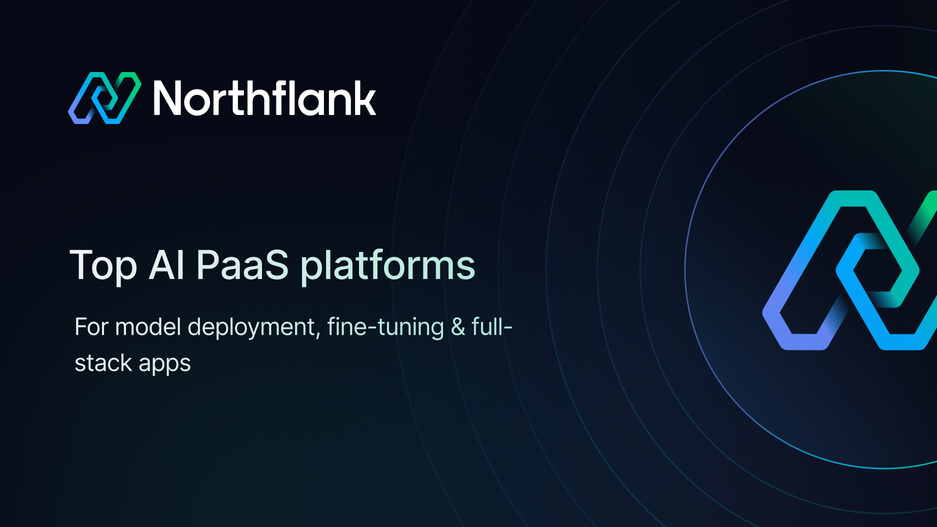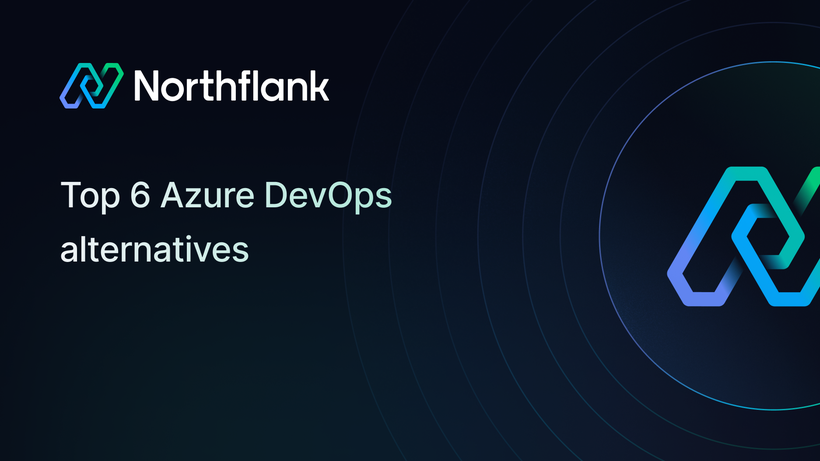

Top AI PaaS platforms in 2026 for model deployment, fine-tuning & full-stack apps
AI PaaS (Platform as a Service) is everywhere right now, and if you’re looking for the top AI PaaS to build or scale your stack, you’re in the right place.
I know you’ve been hearing a lot about it lately, and now you’re likely here to figure out which platform can handle your model deployments, fine-tuning jobs, APIs, and everything in between. Don't worry, I've got you.
And you know what? Some teams are starting to realize that GPU access alone isn’t enough. You now need a full-stack infrastructure that supports databases, background workers, secure runtimes, and observability. And what if I told you that you can get all of that in a single platform?
Well, I won't waste your time with the long story. So, I'll cut to the chase and help you find a platform that doesn’t stop at serving models only.
If you're building or scaling AI apps, these are the platforms you’ll want to check out, some are GPU-focused, others give you full control across your entire stack:
-
Northflank – First on the list because it's a full-stack PaaS with support for model fine-tuning, secure multi-tenancy, APIs, Postgres, Redis, background jobs, and GPU/CPU workloads. Includes BYOC, CI/CD, and fast provisioning for AI workloads in your own cloud or across clouds.
-
Lambda AI – GPU cloud platform built for inference workloads. Prioritizes access to high-end GPUs (A100s, H100s), though lacks broader infrastructure features like database hosting or CI/CD.
-
RunPod – Lets you run containers on GPU machines for training, inference, or notebooks. Popular for spot pricing and rapid experimentation, but not designed for full app deployments.
-
Replicate – Lets you deploy and share ML models as hosted APIs. Great for prototyping and public model sharing, but limited control over infrastructure and customization.
-
BentoML – Framework for packaging and serving models. Ideal if you want to self-host model workloads but need to bring your own infrastructure stack.
-
Together AI – Hosted endpoints for open-source models like LLaMA and Mixtral. Focuses on LLM inference, not broader developer workflows.
-
Baseten – Offers a developer-friendly interface and SDK for deploying ML models with observability and scaling. Better suited for model endpoints than multi-service applications.
-
Anyscale – Built around Ray for distributed compute. Useful for large training jobs, especially if you’re already invested in Ray’s ecosystem.
-
Paperspace (DigitalOcean) – Entry-level GPU platform with notebooks and endpoints. Helpful for solo devs or lightweight inference tasks but lacks enterprise or multi-service support.
-
Hugging Face Inference Endpoints – Managed API access to pre-trained models. Easy to use, but minimal infra flexibility and no full-stack support.
Next, let’s talk about what makes a good AI PaaS before we go through each option in detail.
Can we agree that not all AI PaaS platforms are built the same? I mean, if you're building production-grade AI systems and not prototypes or experiments, there are some non-negotiables you should be looking for.
It's not only about spinning up a model endpoint. You need the kind of platform that can handle production traffic reliably, run fine-tuning jobs, and plug in a vector database.
I’d list some of the things I’d expect from any top AI PaaS today, and yes, platforms like Northflank check all these boxes.
-
Support for both GPU and CPU workloads:
AI workloads aren’t limited to model training only. You should be able to run GPU-intensive training jobs and CPU-based background workers side by side on the same platform without complex setups or separate tools.
-
Secure multi-tenancy:
If your platform runs AI agents or executes generated code, then isolation is important. You should expect a strict separation between users, so that one container can't access or interfere with another.
-
Autoscaling across instance types:
A good AI PaaS should scale both GPU workloads and CPU-based services automatically. You shouldn’t have to manually intervene to keep costs in check or avoid idle resources.
-
BYOC (Bring Your Own Cloud):
You should be able to bring your own cloud account and run workloads across different GPU providers. This gives you more control over pricing, GPU availability, and region-specific deployments.
-
Built-in observability:
You need full visibility into your workloads. Logs, metrics, and deployment history should all be accessible without having to integrate third-party tools manually.
-
First-class support for databases and APIs:
Running a model is only part of the story. You’ll also need infrastructure for vector search, session storage, and APIs, which means built-in support for tools like Postgres, Redis, and vector databases.
-
Fine-tuning and inference:
The platform should support both training custom models and serving them as APIs. You shouldn’t have to switch between multiple tools to cover the full lifecycle.
-
Infrastructure primitives and templates:
You might be spinning up a LLaMA model with one click or managing deployments via GitOps. Either way, the platform should support both high-level templates and low-level control.
-
Enterprise features out of the box:
If you’re deploying at scale, features like RBAC, audit logs, and project-level cost tracking shouldn’t be an afterthought; they should be ready to use from day one.
Now that you know what to look for, let’s go through the top AI PaaS platforms and see what each one supports.
I’ve broken down the top AI PaaS platforms that teams are using in 2026. You’ll see what each one is built for, where it has limitations, and which types of workloads it's best suited for.
Northflank lets you deploy everything in one place. It goes beyond your model and includes the full application stack around it. That includes your GPU and CPU workloads, along with APIs, databases, background workers, and CI/CD pipelines.

What you can run on Northflank:
- You can deploy both your GPU and CPU workloads in one place, including model fine-tuning jobs, inference endpoints, and background workers.
- You can expose APIs that serve your models or power agent backends using built-in CI/CD and autoscaling.
- You can run supporting infrastructure like Postgres, Redis, and vector databases alongside your applications.
- You can manage long-lived jobs, cron tasks, and ephemeral environments without needing external schedulers.
- You can bring your own cloud (BYOC) and run across providers using spot GPU instances or dedicated clusters.
Where it fits best:
- Ideal for teams deploying secure, production-ready AI apps with full-stack infrastructure needs
- Useful if you want to run jobs, APIs, and databases alongside your models without managing separate platforms
- Especially valuable for multi-tenant AI agents, GPU-intensive workloads, and privacy-sensitive deployments
Northflank gives you a secure, full-stack foundation for running production-grade AI apps with GPUs, databases, APIs, and jobs all in one place.
Get started with Northflank by creating an account or booking a demo.
See how Cedana uses Northflank to deploy workloads onto Kubernetes with microVMs and secure runtimes
Lambda AI focuses on giving teams access to high-end GPUs like A100s and H100s without layering on too much platform overhead. It’s designed for ML workloads that prioritize raw compute, particularly for training and inference jobs.
You won’t get managed databases, autoscaling APIs, or built-in CI/CD, but if you already have the rest of your stack figured out and need fast, dedicated GPU machines, then Lambda could be a good choice.

What you can run on Lambda AI:
- Long-running training jobs on dedicated GPU nodes
- Inference endpoints powered by powerful NVIDIA chips
- Notebooks or research experiments with high memory and compute needs
Where it fits best:
- Research teams or ML engineers who want maximum control over compute
- Workloads that depend on specific GPU types (like A100s or H100s)
- Cases where platform simplicity is more important than full-stack features
See Top Lambda AI alternatives to consider for GPU workloads and full-stack apps if you're comparing options for GPU workloads and full-stack app deployment.
RunPod lets you spin up containers on GPU machines quickly, making it a good option for training, inference, or notebook-style development. It's designed for fast experimentation, especially when you don’t need a full application platform around your workloads.

What you can run on RunPod:
- Training jobs, fine-tuning tasks, or inference endpoints in isolated containers
- Jupyter notebooks and interactive dev environments
- Custom Docker images with support for GPUs and spot pricing
- Background jobs or one-off tasks with minimal setup
Where it fits best:
If you’re running GPU-heavy workloads and want a simple way to experiment or test models, RunPod gives you a quick path. But keep in mind, it’s not built for managing full-stack applications or production deployments at scale.
See RunPod alternatives for containerized GPU workloads and full-stack AI apps if you're comparing platforms.
Replicate turns machine learning models into ready-to-use API endpoints with minimal setup. It's a popular choice for sharing open-source models or giving quick access to model outputs without managing your own infrastructure.

What Replicate is best for:
- Running public or open-source models as API endpoints
- Sharing models with others via a hosted interface
- Quickly testing models without building full backend services
It’s not built for full-stack applications, fine-tuning workflows, or custom infrastructure, but if your goal is to deploy a model and get a working endpoint in minutes, Replicate makes that easy.
See Replicate alternatives for teams that need more infrastructure flexibility if you're comparing with more customizable platforms.
BentoML is an open-source framework that helps you turn ML models into production-ready REST APIs. It’s geared toward teams that want full control over how models are packaged, deployed, and served, especially in self-hosted environments.

What you can run with BentoML:
- Model servers built from frameworks like PyTorch, TensorFlow, and scikit-learn
- REST API endpoints for custom ML models
- Containerized services deployed to Kubernetes or other infrastructure
- Multi-model serving with custom logic and batching
Where it fits best:
If you want a framework-first approach to model deployment and prefer to run things in your own environment, BentoML gives you flexibility without forcing a platform. But it does require hands-on infrastructure setup and isn’t designed as a full-stack PaaS out of the box.
See 6 best BentoML alternatives for self-hosted AI model deployment (2026) if you're comparing platforms.
Together AI gives you hosted access to open-source models like LLaMA, Mistral, and Mixtral through prebuilt inference endpoints. It’s useful for teams that want to evaluate or build on top of popular OSS models without running their own infrastructure.

What you can run on Together AI:
- Inference calls to OSS models like LLaMA 3, Mistral, and Mixtral
- Prompt-based generation for chat, text, or function-calling agents
- Basic fine-tuning workflows (LoRA, DPO) for supported models
- API integrations with tools like LangChain
Where it fits best:
Together AI is best for teams that want fast access to open models via hosted endpoints. It works well for prototyping, evaluation, or agent backends that don’t need custom model weights or self-hosting flexibility.
See Top Together AI alternatives for AI/ML model deployment if you're looking for alternative paths to run OSS models.
Baseten provides a UI-driven platform and Python SDK to help you deploy, monitor, and scale models with minimal infrastructure setup. It’s aimed at data science teams who want to get models into production without managing low-level infrastructure.

What you can run on Baseten:
- Model APIs built from Python, PyTorch, or TensorFlow
- Background workers and fine-tuning jobs
- Dashboards and UI-based workflows for model interaction
- Observability for deployed models (logs, metrics, usage)
Where it fits best:
Baseten is an option for teams that want to deploy models with Python and monitor them from a clean UI. It’s useful if you’re focused on fast iteration and want to avoid building your own deployment tools from scratch.
See Top Baseten alternatives for AI/ML model deployment if you're evaluating other platforms.
Anyscale is built on top of Ray, making it well-suited for running distributed AI and Python workloads across multiple nodes. It abstracts a lot of the complexity behind Ray while giving you the flexibility to scale large jobs without managing the infrastructure manually.

What you can run on Anyscale:
- Distributed training or hyperparameter tuning with Ray
- Batch inference jobs across GPU and CPU clusters
- Python-based AI agents and pipelines
- Workflows that require autoscaling across many machines
Where it fits best:
If you're working on large-scale distributed AI workloads and want a managed Ray environment with autoscaling, Anyscale is an option. It’s relevant for research and production teams building custom training pipelines.
See Top Anyscale alternatives for AI/ML model deployment if you’re checking out similar platforms.
Paperspace, now under DigitalOcean, gives you an accessible starting point for running Jupyter notebooks, launching GPU-powered VMs, and deploying models via Gradient endpoints. It’s designed more for experimentation than full-stack AI apps, but it’s a familiar entry point for many developers.

What you can run on Paperspace:
- Jupyter notebooks with access to entry-level or mid-tier GPUs
- Inference endpoints using preconfigured environments (via Gradient)
- Containerized training or fine-tuning jobs with basic orchestration
- Small-scale applications where a single notebook or endpoint is enough
Where it fits best:
If you're starting with GPU workloads or want to test models in a notebook environment before scaling up, Paperspace can be a low-barrier option. Just keep in mind that it’s not built for running multi-service, production-grade AI apps.
See 7 best DigitalOcean GPU & Paperspace alternatives for AI workloads in 2026 if you're comparing platforms.
Hugging Face provides a quick path to deploy open-source models as production-ready APIs without managing infrastructure. It’s great if your model is already hosted on the Hub or if you’re working with pretrained models from the Hugging Face ecosystem.

What you can run with Hugging Face Inference Endpoints:
- Pretrained models from the Hugging Face Hub (e.g., BERT, LLaMA, Mistral)
- Custom fine-tuned models pushed from your local workflow
- Real-time inference APIs with autoscaling and basic monitoring
- Transformers-based pipelines with simple deployment configs
Where it fits best:
This is a good choice if you're focused on deploying public or fine-tuned Hugging Face models as APIs and don’t want to worry about backend setup. It’s less suited for teams building custom infrastructure or multi-service apps around those models.
Most AI PaaS platforms are focused on a narrow slice, usually model inference. However, if you're building production-grade systems, that’s not enough. You need full-stack deployment, workload isolation, flexible cloud choices, and support for the entire lifecycle.
Northflank is designed to run real-world AI applications, not only demos or endpoints. It brings together GPU provisioning, secure runtimes, CI/CD pipelines, background jobs, databases, and more on a single platform.
- Bring Your Own Cloud (BYOC): Run across your own cloud accounts with spot or on-demand GPUs from AWS, GCP, Azure, and more
- Secure runtimes: Run untrusted agents and generated code in isolated microVMs with MTLS and project boundaries
- Databases and vector search: Spin up Redis, Postgres, and Qdrant alongside your services with no external setup needed
- Multi-service support: Deploy inference endpoints, APIs, background jobs, and workers in one place
- Built-in CI/CD: Trigger builds and deployments from your Git repo with zero-config pipelines
- Custom templates and infrastructure primitives: Use prebuilt templates for Jupyter, LLaMA, or fine-tuning, or roll your own setup
- Enterprise readiness: Get audit logs, RBAC, billing groups, and cost tracking from day one
1. What is AI PaaS?
AI PaaS (Platform as a Service) refers to platforms that let you build, deploy, and scale AI workloads, like model training, inference, and background jobs, without managing the underlying infrastructure. These platforms typically combine compute, APIs, databases, and developer tools in one place. Here’s a deeper explanation of what AI PaaS means.
2. What are the top 5 AI PaaS platforms?
Five notable platforms widely used in 2026 include Northflank (full-stack deployment with secure runtimes, CI/CD, and BYOC), Lambda, RunPod, Replicate, and BentoML.
3. What makes a good AI PaaS?
A good AI PaaS should support both GPU and CPU workloads, offer built-in observability and autoscaling, support fine-tuning and inference, and include first-class support for APIs, databases, and secure multi-tenancy. The best ones also let you bring your own cloud (BYOC) and give you templates for managing infrastructure and deployments.
4. Is there a free AI PaaS?
Yes, several platforms include free tiers. Northflank has a free plan for CPU workloads and service deployments. Replicate lets you use public models for free with rate limits. RunPod offers occasional credits and affordable pricing for GPU access.
5. Can I fine-tune my own models on an AI PaaS?
Some platforms support full fine-tuning workflows while others are built just for inference. Northflank, RunPod, and BentoML support fine-tuning. Replicate and Hugging Face Inference Endpoints are more focused on serving pre-trained models.
6. Which AI PaaS is best for startups vs enterprise teams?
Startups might prioritize fast iteration and lower GPU costs, making Lambda or RunPod appealing. Enterprise teams typically need more security, audit trails, cost tracking, and the ability to bring their own cloud, areas where Northflank is designed to meet those requirements.

